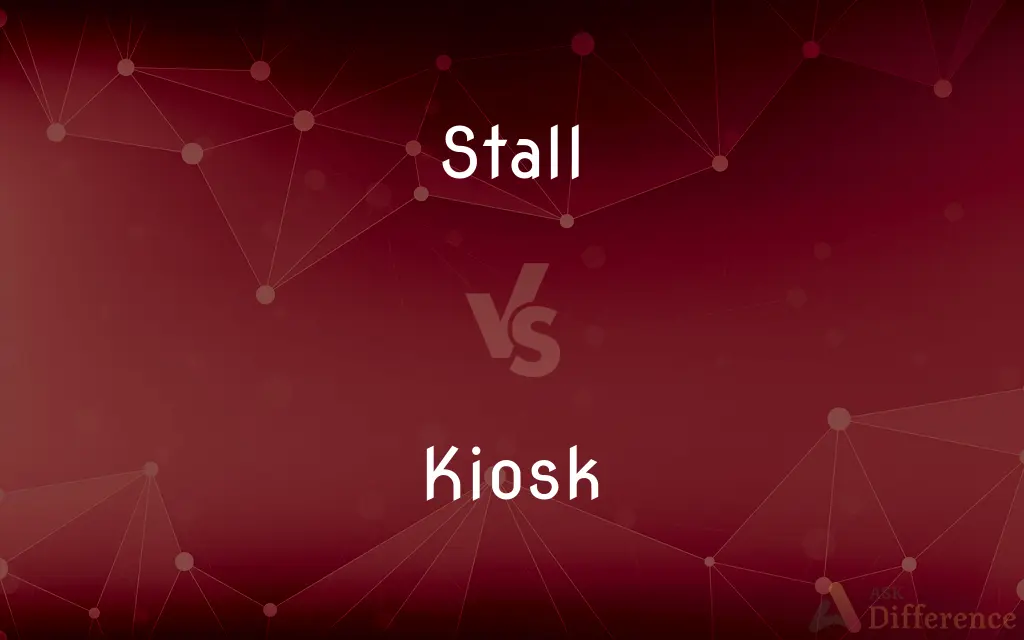Stall vs. Kiosk — What's the Difference?
Edited by Tayyaba Rehman — By Maham Liaqat — Updated on February 28, 2024
A stall is a stand or booth for selling goods, often temporary and open-air, while a kiosk is a small, often enclosed structure used for selling or displaying information, frequently found in malls or public spaces.

Difference Between Stall and Kiosk
Table of Contents
ADVERTISEMENT
Key Differences
Stalls are typically associated with outdoor markets or trade fairs, where vendors sell goods or food from a designated space. These can be temporary setups, easily dismantled and moved. Kiosks, however, are more permanent structures, often enclosed, found in indoor environments like shopping malls or as standalone units in public areas for selling goods or providing information.
The design of a stall is usually open and accessible, allowing for direct interaction between the vendor and the customer. This setup is conducive to haggling and offers a personal touch. Kiosks, on the other hand, might be fully or partially enclosed, equipped with technology such as touch screens for interaction, emphasizing self-service or digital information display.
Stalls often require minimal infrastructure and can operate without electricity, relying on natural light and temporary shelter. Kiosks, in contrast, are typically equipped with electrical connections to support digital displays, refrigeration, or other technology, catering to a modern shopping experience.
The nature of goods sold at stalls and kiosks can also differ. Stalls are commonly used for selling fresh produce, handmade crafts, or food items, reflecting a traditional market atmosphere. Kiosks are more versatile, selling a wide range of products from newspapers and coffee to electronics and cosmetics, often focusing on convenience and specialty items.
Stalls and kiosks serve different purposes and target audiences. Stalls, with their temporary and flexible nature, appeal to those looking for fresh, local, or unique items in an open-air setting. Kiosks cater to consumers in high-traffic areas, offering quick purchases, information, or services in a more controlled environment.
ADVERTISEMENT
Comparison Chart
Location
Typically outdoor markets, fairs
Indoor malls, public spaces
Structure
Open, temporary
Enclosed, often permanent
Design
Minimal, direct customer interaction
May include technology, designed for self-service
Infrastructure
Minimal, possibly no electricity
Requires electricity for operation
Goods/Services Sold
Fresh produce, crafts, food
Newspapers, coffee, electronics, cosmetics
Purpose
Selling in a traditional market atmosphere
Selling or providing information in high-traffic areas
Target Audience
Customers looking for fresh, local, unique items
Consumers seeking convenience, quick purchases
Compare with Definitions
Stall
An art stall displays handmade crafts.
Her stall at the fair was popular for unique pottery.
Kiosk
An information kiosk provides tourist information.
The information kiosk at the mall had maps and event flyers.
Stall
A market stall offers fresh fruits and vegetables.
The farmer's stall is always crowded for its organic produce.
Kiosk
A ticket kiosk dispenses tickets for transport or events.
We got our cinema tickets from the automated kiosk.
Stall
A book stall sells used and new books.
I found rare novels at the downtown book stall.
Kiosk
A coffee kiosk serves quick beverages.
The coffee kiosk in the lobby is perfect for a quick caffeine fix.
Stall
A food stall serves street food.
The food stall on the corner makes the best tacos.
Kiosk
An electronic kiosk for self-service tasks.
I paid my parking fee at the electronic kiosk.
Stall
A flower stall offers a variety of blooms.
The fragrance from the flower stall filled the market.
Kiosk
A retail kiosk sells specialty products.
The cosmetics kiosk offers high-end skincare samples.
Stall
A booth, cubicle, or stand used by a vendor, as at a market.
Kiosk
Historically, a kiosk (from Persian kūshk) was a small garden pavilion open on some or all sides common in Persia, the Indian subcontinent, and in the Ottoman Empire from the 13th century onward. Today, several examples of this type of kiosk still exist in and around the Topkapı Palace in Istanbul, and they can be seen in Balkan countries.
Kiosk
A small structure, usually open in front, used as a newsstand or a place for selling goods or conducting transactions, as at a bank.
Common Curiosities
Are kiosks always digital or automated?
Not always, but many kiosks are equipped with digital technology for selling goods, providing information, or offering services through automation.
Is it cheaper to operate a stall or a kiosk?
Generally, operating a stall can be cheaper due to its minimal infrastructure and temporary nature, whereas kiosks might incur higher costs due to technology and location.
Can stalls be found indoors?
While less common, stalls can be found indoors, especially in large open spaces like indoor markets or exhibition halls.
How do customers interact differently with stalls vs. kiosks?
Customers interact directly with vendors at stalls, often leading to personal service and haggling, while kiosks may offer self-service options or digital interactions.
Can kiosks be part of a larger store?
Yes, kiosks can serve as smaller, specialized units within larger stores or malls, offering specific products or services.
Can kiosks be temporary?
While kiosks are often permanent, temporary kiosks are also common, especially in seasonal or event-specific contexts.
Why are kiosks popular in malls?
Kiosks utilize limited space efficiently and cater to high foot traffic, offering convenience and quick purchases in busy indoor environments.
What is the main difference between a stall and a kiosk?
A stall is an open, often temporary setup for selling goods, typically outdoors, while a kiosk is a more permanent, often enclosed structure found indoors or in public spaces for selling or information.
Do stalls and kiosks sell the same types of products?
They can sell similar products, but stalls are traditionally associated with fresh produce or crafts, while kiosks often focus on convenience items or specialty goods.
Do stalls and kiosks require different permits?
Yes, the permits may vary based on location, permanence, and the nature of goods or services sold, with kiosks often facing stricter regulations due to their setup.
What impacts the location choice for a stall or kiosk?
Factors include target audience, foot traffic, product type, and environmental conditions, with stalls favoring open, populous areas and kiosks opting for high-traffic indoor spaces.
How do technology advancements affect kiosks?
Technology advancements enhance kiosk functionality, allowing for more automated services, digital displays, and interactive customer experiences.
Can a stall become a kiosk?
A stall can evolve into a kiosk if it adopts more permanent features, enclosure, and technology, transitioning to a more fixed location.
Which is more traditional, a stall or a kiosk?
Stalls are more traditional, with a history rooted in open-air markets and trade fairs, predating the more modern, enclosed kiosk.
How do weather conditions affect stalls and kiosks?
Stalls, especially outdoors, can be significantly affected by weather, while kiosks, being more enclosed or indoors, are less susceptible.
Share Your Discovery

Previous Comparison
Crest vs. Tuft
Next Comparison
Flexible vs. PliableAuthor Spotlight
Written by
Maham LiaqatEdited by
Tayyaba RehmanTayyaba Rehman is a distinguished writer, currently serving as a primary contributor to askdifference.com. As a researcher in semantics and etymology, Tayyaba's passion for the complexity of languages and their distinctions has found a perfect home on the platform. Tayyaba delves into the intricacies of language, distinguishing between commonly confused words and phrases, thereby providing clarity for readers worldwide.
















































